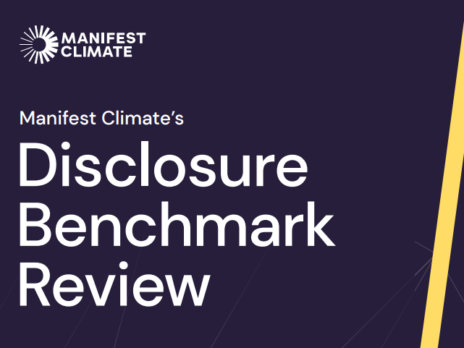

Climate efforts and insights must be scaled up significantly in scope and speed if we are to successfully transition to a net-zero economy.
As the window becomes ever smaller, urgency grows. Businesses waking up to the criticality of placing climate at the heart of their strategic decision-making find themselves in fierce competition for that most precious of resources: expertise.
“There needs to be a mindset shift, an understanding that everyone must go through this transformation,” says Jeremy Greven, co-founder and president of Manifest Climate. “Access to climate capabilities and insights needs to be massively scaled up and the only way of achieving that is through technology.”
Entrepreneurs and investors are increasingly recognising the potential rewards of bridging that gap. PwC reports that more than $0.25 in every dollar of venture capital funding went into climate technology in 2022, with climate tech becoming an increasingly crowded marketplace. However, Greven, whose background lies in the tech start-up scene, sees much of this activity as being concentrated upon quite a narrow aspect of the climate challenge.
“Its newness means people lump everything in together,” says Greven. “In raising our first two rounds of venture capital [Manifest Climate has raised CA$36.5m to date], we talked to more than 100 VC firms. I can’t tell you how many times they told us they were invested in a competitor. Nine in ten of these “competitors” were carbon accounting platforms.
“People coming out of the Facebooks or Googles, with purely tech backgrounds, see this as an important space and are looking for a low-hanging problem to tackle. That’s typically GHG accounting, but metrics are only one of the four TCFD [Task Force on Climate-related Financial Disclosures] pillars. We see ourselves as a level beyond that: how do you bring meaningful data back into your business and form an action plan around it? What do an effective climate strategy and good governance look like?”
The best of human and machine
Manifest Climate’s overarching goal is to provide clients with decision-useful information that enhances and accelerates their climate journeys. Its platform leverages machine learning algorithms to surface best practices by rapidly reviewing public disclosure documents. Climate insights and evaluations that would once have been delivered manually, often at great expense, are achieved at a fraction of the time and cost.
Greven says the use of artificial intelligence (AI) and machine learning (ML) within this space was “almost non-existent” when he began working in climate three years ago, though that picture is slowly changing. He points to the TCFD’s annual Status Report as one early example. “We were very excited by the status report, but upon digging into it, realised the findings were very high level,” he recalls. “It was produced using natural language processing, but focused more on the broad alignment of disclosures with the TCFD recommendations, rather than evaluating quality. That helped focus our minds about what it might look like done in a way where companies can dig in and identify specific areas of improvement against peers and competitors.”
Doing it properly meant fusing the best in data and climate science. While Greven boasts significant skills in the former, his co-founder and CEO, Laura Zizzo, and a team of climate experts, bring a level of subject expertise not typically found in the climate tech start-up space.
Through this combination of human and tech expertise, Manifest Climate’s assessment models can evaluate how well an organisation’s climate-related disclosures align with different frameworks and standards – both in broad terms and in regard to “decision-usefulness”. The models have been trained on a database of thousands of public disclosure documents, previously assessed and labelled by Manifest Climate’s climate experts.
Its alignment model examines whether an organisation’s disclosures broadly address the information called for by the TCFD, and equivalent frameworks and standards. Leveraging ML and natural language processing, it scans public disclosures to evaluate them against its proprietary methodology. This can be done on an incredible scale.
Manifest Climate’s Disclosure Benchmark Review assessed the public filings of over 3,000 organisations from 65 countries. For context, the most recent TCFD Status Report assessed less than half that number. Findings can then be broken down in a number of useful ways, including by TCFD pillar, individual recommendation, sector and geography, as well as providing far greater opportunity to extract trends and gaps across multi-year time periods.
“We built a time machine,” says Greven. “Our machine is capable of evaluating TCFD alignment as far back as 2018. It is incredible to see global coverage growing year over year.”
If the alignment model highlights the sheer volume leveraging automation affords, Manifest Climate’s decision-utility model showcases the extent to which genuine insight and nuance can be scaled. Companies can easily employ the right language to demonstrate TCFD alignment, but is what they’re saying actually delivering valuable information and insight to the market?
Manifest Climate’s model breaks recommendations down into precise requirements for providing decision-usefulness – and analyses whether they are present in a disclosure document. This enables the platform to quickly differentiate between those organisations for whom the alignment is more of a box-ticking exercise and those that are truly putting climate considerations at the heart of their business strategies.

“We have some of the world’s leading climate experts aligned with some of the best data scientists, working together on a common problem – that is the magic of Manifest Climate,” says Greven. “Without climate expertise, building the models would be impossible. And without the data scientists, that expertise is not scalable. Our team was doing consulting work long before I showed up. We know what good looks like and that’s how you train a model: here’s what we want to see, go find more of it.”
Typically, those looking for such services would need to invest in bespoke, one-to-one solutions provided by big consultancy firms. With TCFD-aligned disclosures soon becoming mandatory for 85% of global GDP – tens of thousands of companies – the industry needs to change. Models such as those provided by Manifest Climate are designed to empower these expert climate insights to be scaled at speed.
Manifest Climate began by working with financial institutions and investors typically much further along in this journey. While they remain a bedrock of its client base, there is a growing focus on organisations where climate strategy remains in its infancy. Climate consultancies are also showing interest, though a number still consider Manifest Climate to be a direct competitor – “The work that we can do very efficiently remains manual billable hours for them,” Greven explains.
Such attitudes reflect the need for greater collaboration within the climate services ecosystem, particularly as new models and capabilities emerge.
The climate insight learning curve
Along with volume, the ability to constantly improve and refine such services is also central to the value proposition. As investor and regulatory pressures evolve, companies’ tools must be able to adapt in lockstep. Different businesses often face certain sector-specific challenges and priorities, and Manifest Climate is developing vertical-specific transition risk parameters to address these requirements.
At the same time, TCFD is industry agnostic, so lessons on best practices can be pulled from anywhere. Businesses leveraging Manifest Climate’s models can glean insights from across sectors and geographies that would not be available otherwise.
“If you are doing this manually, scanning for best practice, you would never think to look anywhere beyond your peers,” says Greven. “That seriously limits your scope. Our belief is that you can learn from those who have gone before you. We surface best practices from across all companies reporting publicly, providing clear examples of what good climate governance and strategy look like when it comes to transition, laying out what you need to know and how you should be getting there.”
While tech will play a critical role in deciding transition success, it should never be seen as providing business leaders with a free pass to outsource their climate strategies. “It will always be a balance, no matter how smart computers get,” Greven cautions. “We produce insights which can dramatically accelerate how fast you get to those moments of deep clarity. But it’s ultimately you, your board, your management team, who must strategise and execute.”
But one should not consider embarking upon this journey alone. Those enterprises still having “build versus buy” conversations around climate services are not recognising the extent to which climate tech has the potential to transform this space. Companies solely focused on the climate challenge, with millions in VC capital invested into building industry-first models, can offer insights, capabilities and platforms unavailable through traditional consultancy services – and are prohibitively expensive to develop in-house.
“When you use an Amazon or a Google, you stand on the shoulders of giants,” says Greven. “That’s what we want to provide in the climate space; leverage our scale and expertise by standing on our shoulders.”
For those yet to make that climb, there is still time – but the window is closing. It is also not companies’ ESG or tech teams who need to be leading from the front. Manifest Climate is increasingly finding itself speaking directly to the CFO and CEO when onboarding new clients but, like so many other aspects of the climate challenge, it is a trend Greven and his team would like to see accelerate.
“The shoe still hasn’t quite dropped in the C-suite regarding the magnitude of transformation that needs to be undertaken,” he says. “But that realisation is going to come quickly and, when it does, there’ll be no choice but to turn to technology in order to acquire the insights and speed necessary to successfully navigate a climate-adjusted future.”







